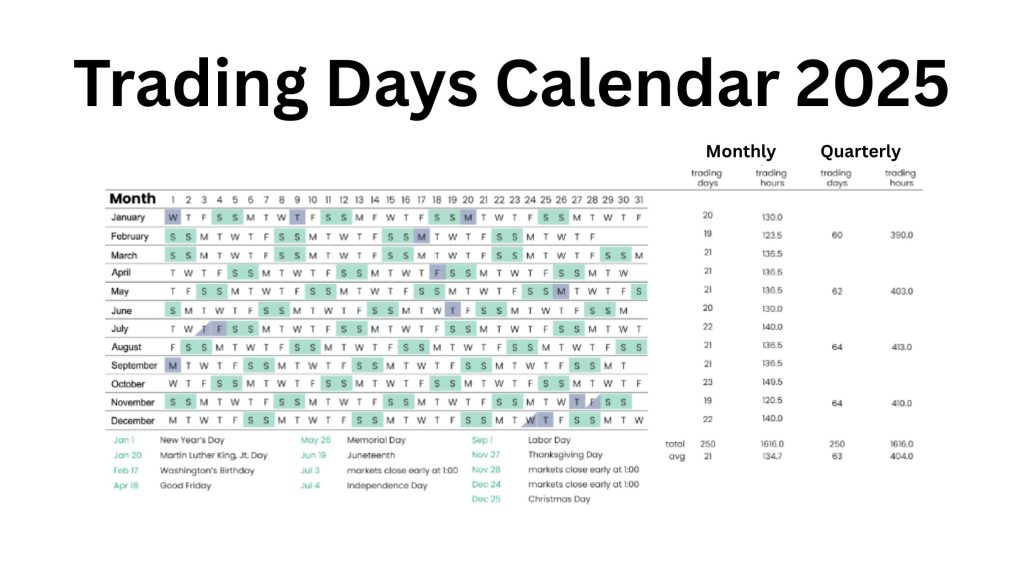Are you wondering how many trading days in a year? If you’re a trader, investor, or financial planner, knowing the exact number of trading days helps with strategy, performance tracking, and planning. In this article, we break it down simply and clearly.
What Is a Trading Day?
A trading day is any day when a stock exchange is open for buying and selling financial assets. In the U.S., this typically means Monday through Friday, excluding major public holidays. Trading days exclude weekends and holidays when markets are closed.
How Many Trading Days Are There in a Year?
In a typical calendar year, there are 252 trading days in the United States. However, this number can vary slightly depending on how holidays and weekends fall. For instance:
- There are 251 trading days in the U.S in 2025.
- Leap years may have one more calendar day but not necessarily more trading days.
How Many Stock Trading Days in a Year?
Whether you’re trading stocks on the NYSE, NASDAQ, or another U.S. exchange, you’ll generally encounter 250 to 253 stock trading days per year. This excludes weekends and federal holidays when markets are closed.
How Many Trading Weeks in a Year?
A trading week typically consists of 5 trading days. So:
- 252 trading days ÷ 5 = Approximately 50 trading weeks per year
This helps traders plan their strategies and assess performance weekly.
Major Public Holidays in the U.S.
U.S. markets are closed on the following federal holidays:
- New Year’s Day
- Martin Luther King Jr. Day
- Presidents’ Day
- Good Friday
- Memorial Day
- Independence Day
- Labor Day
- Thanksgiving Day
- Christmas Day
If these holidays fall on weekends, markets may close on the preceding Friday or following Monday.

Differences Between Trading Days and Calendar Days
| Type of Day | Number per Year |
| Calendar Days | 365 (or 366 leap year) |
| Weekends | 104 |
| Trading Days | ~252 |
Trading days are business days when exchanges are open, not simply any weekday.
How To Calculate Trading Days?
To manually calculate how many trading days in a year:
- Start with 365 calendar days.
- Subtract 104 weekend days (52 weeks × 2).
- Subtract 9-11 public holidays observed by stock markets.
Example: 365 – 104 – 10 = 251 trading days
How Many Trading Days in Global Markets?
Trading days differ by country and exchange due to local holidays and time zones.
New York Stock Exchange (NYSE) – 2025 Holidays
- Closes for 10 U.S. federal holidays
- 251 trading days expected in 2025
London Stock Exchange (LSE) – 2025 Holidays
- UK public holidays (e.g., Easter, Boxing Day)
- Around 253 trading days annually
Hong Kong Exchanges and Clearing Limited (HKEX) – 2025 Holidays
- Hong Kong observes more holidays than Western markets
- About 245–250 trading days annually
What Is a Trading Session?
A trading session refers to the active hours of the stock market on a given trading day. For the NYSE:
- Regular hours: 9:30 AM to 4:00 PM EST
Other markets follow local time zones.
How a Trading Session Works
Each session has distinct phases, each with unique market behavior:
- Opening bell: High liquidity and volatility
- Midday: Often slower volume
- Closing bell: Intense trading as positions are adjusted
What Are Extended Trading Hours?
Extended hours allow trading before and after regular sessions:
- Pre-market: 4:00 AM – 9:30 AM EST
- After-hours: 4:00 PM – 8:00 PM EST
Not all brokers support these sessions.
Which Markets Offer Extended Trading Hours?
Extended trading availability varies by exchange:
- NASDAQ and NYSE: Yes
- LSE: Limited
- HKEX: No pre-market, but limited extended hours for futures
What Is the Best Time of the Year for Trading?
Some times of year offer better opportunities due to seasonal trends or earnings reports:
- January Effect: Stocks often rise in early January
- Earnings Seasons: Increased volatility (Jan, Apr, Jul, Oct)
- Holiday Season: Lower volume, less volatility
Conclusion
Now that you know how many trading days in a year, you can better plan your strategy. Whether you trade stocks, ETFs, or other assets, understanding how many stock trading days in a year helps you align your goals with the market calendar.
Remember, the number of trading days in a year isn’t fixed globally, it varies based on holidays and local practices. Always check your exchange’s calendar before planning.
For more trading insights, tools, and expert market analysis, visit Ultima Markets. We are your trusted partner in navigating global financial markets.







![[MetaTrader 5 Mobile Trading Complete Guide] 7 Key Advantages for Real-Time Market Access](https://www.ultimamarkets.com/wp-content/uploads/2025/04/mt5_mobile_trading_card.jpg)
















